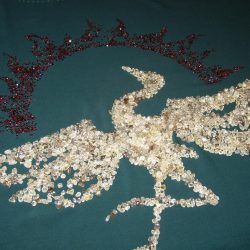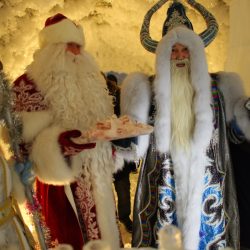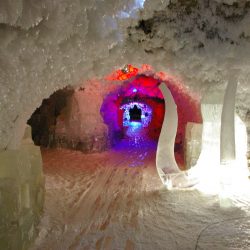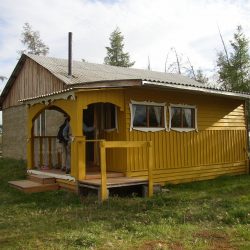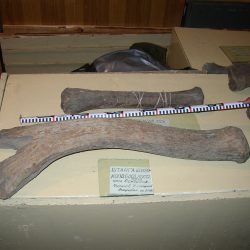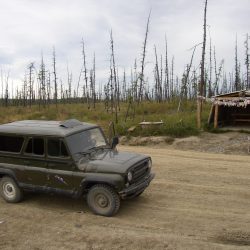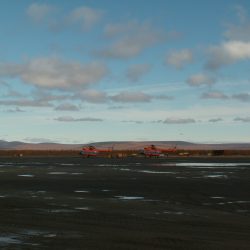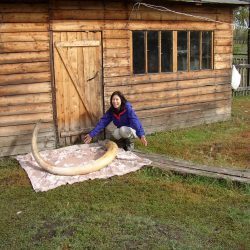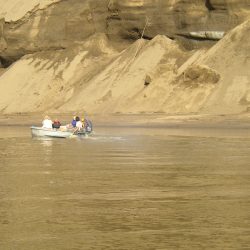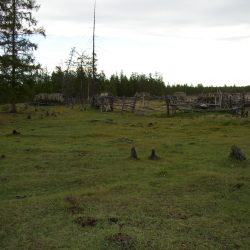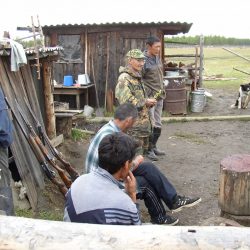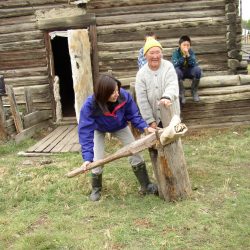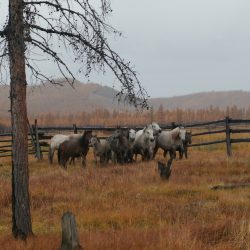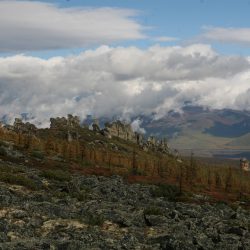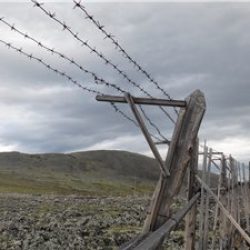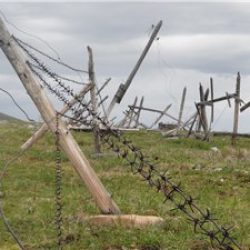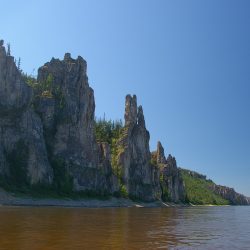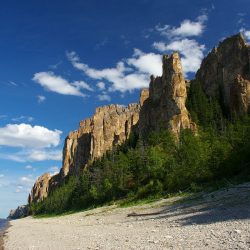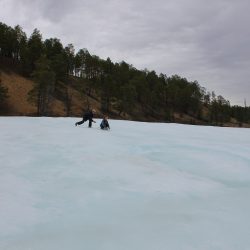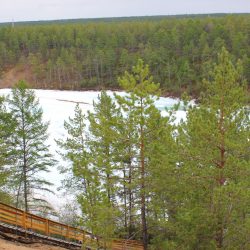Highlights: Mammoth graveyards, gulag concentration camp, indigenous Yakut horse herders, trekking to sacred kisilyakh rock pillars, visiting 100-metre deep sinkhole that appeared inexplicably 10 years ago, Lena Pillars UNESCO World Heritage Site, underground permafrost laboratory.
Description: guests will be exploring one of the wildest, remotest, least explored parts of the planet: Arctic Yakutia. Yakutia, a province the size of India but with a population of only 900,000, receives only a handful of tourists every year. Arctic Yakutia has almost never been visited by foreign tourists. This route takes travelers to places rarely seen by outside eyes, to meet and live with people who live 1000km from the nearest road or railway, who have never met or even seen a foreigner before. Travellers will make genuine scientific discoveries of mammoth bones or, if lucky, tusks. They will visit a sinkhole bigger than the more famous Yamal Peninsula ones but which has yet to be discovered by the media, will visit a well-preserved gulag concentration camp and will see the spectacular kisilyakh sacred stones and the Lena Pillars.
Time of year: July / August
Number of participants: 2 – 6
Day 1: Evening flight from Moscow to Yakutsk (7 hours flight, 6 hours time difference).
Day 2: Arrive in Yakutsk, the capital of Yakutia. Yakutia is home to several indigenous groups, in particular the Yakut people who number around half a million. These Asian-featured people have a well-preserved animistic, shamanistic religion and a language completely unrelated to Russian. When the Russians began conquering Siberia in the 16th century, many indigenous languages died out. Yakut was the only language where the opposite happened and Russian people began using it instead of Russian. It is spoken as a first language by 90% of Yakuts to this day, and there are still people, both Yakut and Russian, who barely know the Russian language!
Yakutia is the coldest inhabited part of the world. While summer temperatures in this land of extremes can reach +40C, winter temperatures in the -70s have been officially registered, and unofficially in the -80s!
On this day we will have a city tour, visit the Dom Archi where Yakut people come to worship, visit the mammoth museum, visit an open-air ethnographical museum, visit the permafrost museum and the permafrost laboratory. This is an underground laboratory hacked into the permafrost itself where scientists study the permafrost and its effects on different materials, to help city architects construct buildings more resistant to its destructive effects.
Overnight in hotel.
Day 3: 2-hour flight from Yakutsk to Batagay (1 hour ahead of Yakutsk, 7 hours ahead of Moscow). This is a small town of 3800 people in Verkhoyanskiy District of Arctic Yakutia. A thousand kilometres north of the nearest road or railway, it is very isolated from the southern part of Yakutia. In summer it is only accessible by boat, or in winter by driving on the frozen river surface. It was in Verkhoyanskiy District that the world’s coldest ever temperatures in inhabited places were recorded.
Batagay has hyge underground tunnels hacked into the permafrost where meat and fish can be stored year-round, as pictured above.
From Batagay we travel 46km in Russian UAZ vehicle to the Yakut village of Betenkyos (population 800). Tour of the village, visit the small historical / paleontological museum. Fishing on the river can be organized, if guests so desire.
As there are no hotels in Betenkyos, guests will be staying with local families in their homes, 2 – 3 people in each home.
Day 4: After breakfast, travel 1.5 hours in motorboats to a nearby mammoth graveyard. This is an area where every summer the melting permafrost pushes bones, tusks and teeth of ancient fauna out of the ground and river banks. Remains of mammoths, sabre-toothed tigres, bison, cave lions and woolly rhinoceros can be found just lying around on the ground. Over the course of the trip, these finds are guaranteed 100%. We will bring with us a paleontologist from Yakutsk who will be able to explain what animals the bones we find belonged to and which parts of the animal they were from.
We will have a picnic lunch and return to Betenkyos in the evening.
Day 5: We return to the mammoth graveyard to continue our paleontological search. Picnic lunch and return to Betenkyos in the afternoon.
After returning to Betenkyos we will travel to a nearby community of indigenous Yakut horse herders who live in traditional log cabins on an island in the river. Horse herding was always the traditional Yakut way of life, and their horses are very unusual – short, fat-bellied and with shaggy hair up to a metre long that keeps them warm outside in the freezing cold winters. The Yakut horses from Verkhoyanskiy District are considered the purest, best and most thoroughbred.
Day 6: Travel 2.5 hours by motorboat. Disembark and set up tents.
Hike up the mountain (1070 metres above sea level) to the kisilyakh rock pillars. These are giant fingers of rock, averaging 35 metres in height, which stick up bizarrely out of the surrounding grass.
Yakut people consider them sacred, and legend goes they were once giants who lived in the area but got turned to stone for their sins. On reaching the top it is Yakut tradition to perform ritual worship of the Spirit of the Mountain, express good will to your companions and make wishes.
Go back down and overnight in tents.
Day 7: Hike up a different mountain to different kisilyakh. Overnight in tents.
Day 8: 2.5 hours to Betenkyos by motor boat. Lunch with families in local homes. Return to Batagay.
Travel 10km to a nearby sinkhole which appeared inexplicably 10 years ago much like the more famous Yamal Peninsula sinkholes. However, unlike the Yamal Peninsula sinkholes, the media has not yet discovered this one, so there may be a scoop here for any journalists among the guests!
This sinkhole is over 100 metres deep at its deepest point, 1.5 kilometres long and 800 metres wide. It gets about ten metres deeper every year. .
We descend into the sinkhole, where remains of mammoths, ancient bison and ancient horses can be found.
Overnight in hotel in Batagay.
Day 9: Travel 40km to Kestyor, a well-preserved gulag concentration camp where tin was mined in the times of Stalin, when millions were worked, starved and frozen to death. Of all the camps in Yakutia, Kestyor had the most brutal conditions, and winter temperatures below -60C. Wooden watchtowers, barbed wire fences, buildings and equipment from those times remain intact at Kestyor, amid stunningly beautiful mountain scenery.
Picnic lunch then return to Batagay. Excursion around the town. Visit huge underground tunnels hacked into the permafrost which locals use like refrigerators for meat and fish. Overnight in hotel.
Day 10: Fly back to Yakutsk. The afternoon can then be spent souvenir shopping (lots of good fur clothing can be bought, plus carvings from mammoth tusks, reindeer and elk bones, etc) or visiting museums.
Overnight in hotel.
Day 11: Drive to the quaint Yakut village of Elanka, a collection of wooden cottages on the banks of the Lena, Russia’s longest river. Take motorboats down the river to the Lena Pillars, a UNESCO world-heritage site where hundreds of huge rock fingers up to 300 metres tall line the riverbanks for a distance of several kilometres.
Disembark, have a picnic lunch, then follow a path up the steep river banks to the tops of some of the pillars.
Return to Yakutsk in the evening.
Day 12: Reserve day in case bad weather delayed the flight from Batagay to Yakutsk.
If the flight is delayed, this spare day will of course be spent in Verkhoyanskiy District. We will take a road trip to Verkhoyansk, a village of 1100 people where the coldest ever temperature in a settlement was recorded. We will visit the excellent local museum, meet the local mayor, and visit the town’s monument – a 15-metre tall pair of mammoth tusks jutting out of the ground!
If the flight is not delayed, this spare day will of course be spent around Yakutsk. We will cross the River Lena on a ferry and travel to a beautiful valley with a glacier known as Buluus. We can walk on the surface of the glacier, explore the ice caves and tunnels underneath, and roast shashlik (a Russian / Yakutian-style barbecue of meat on skewers) nearby.
Overnight in hotel.
Day 13: Fly from Yakutsk to Moscow, arriving around morning or midday.


